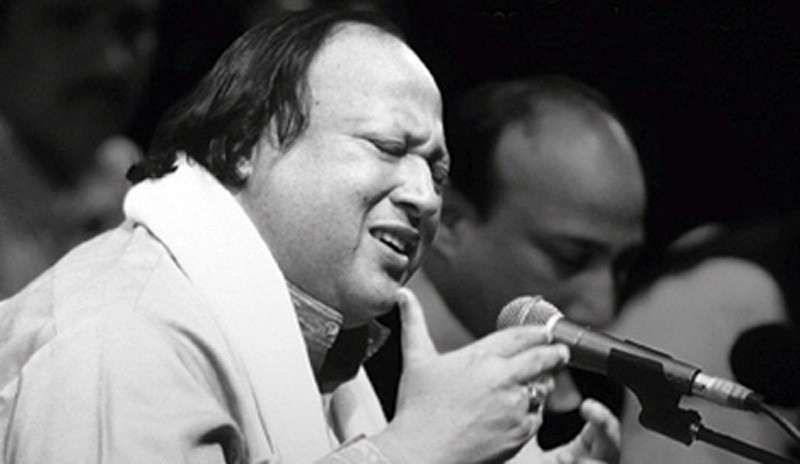
An Urdu translation of a French book on Nusrat Fateh Ali Khan that makes his life and work available to the Urdu-reading public

Despite the great popularity of Nusrat Fateh Ali Khan, the most well-known international star of music that Pakistan has produced, not much has been written on him. Actually not much has been written about the various well-known musicians and vocalists of the country in general. But, in his case, it is more poignant because he had an international following, and writing about music is not as alien to them as it may be to us.
Aqeel Ruby wrote on him in a book format called Nusrat Fateh Ali Khan -- a Living Legend and then Pierre-Alain Baud who is French had written about Nusrat Fateh Ali in his native language. Now the same book has been translated into Urdu by Shaukat Niazi with some additions and is available to the Urdu-reading public.
The most revealing details are included in the chapter where the place of Nusrat Fateh Ali has been recounted and detailed. According to Baud, the popularity of Nusrat has increased all round the world after his death and there are many indicators pointing in that direction. A postage stamp was issued in Pakistan by Pakistan Post after his death and in 2001 a film was made on him by Giuseppe Asaro -- "Nusrat Fateh Ali Khan-A Voice from Heaven". In 2001 Womex (The World of Music Expo) bestowed upon him a posthumous award.
In 2006 the New York Times placed him among the sixty "Most Influential Asians". In 2010, NPR (National Public Radio) placed him in the fifty great voices and the same year CNN listed him in the "The Fifty Great Voices of the half century".
The author claims the sales of Nusrat’s, both of concerts and studio recordings, is much more than the number mentioned in the Guinness Book of Records. In 2013, Oriental Star Agencies released many CDs, Casessttes and DVDs with another set where many of the celebrities have paid their respects to Nusrat Fateh Ali Khan. In Pakistan, Rehmat Recording Company released more than hundred albums while Sonic released more than fifty CDs and Cassettes. VCR, a distribution company in 1998, released an album called the "Swan Song -- His Final Performance" and in 2001 The Final Studio Recording, an American Company and Capital/Virgin Company in 2004, released Ultimate Volume 1 and 11. Real World also released his recordings posthumously Body Soul and Dust to Gold while Koch International released many recordings of Nusrat in 2007. OSA released an album called the Dub Qawwali, a remix with electronic music through Six Degree Records, and it was recommended for an award. According to Amazon.Com it remained on top of the highest selling records of electronic music.
Sufi Soul in 1998 and also the same year Network Company released albums paying homage to him. The following albums were released which have included the famous numbers of Nusrat Fateh Ali Khan.
When Womad (World of Music, Arts and Dance) was being formed in the 1080s Pete Townshend of the rock group The Who through the offices of Muhammed Ayub of the Oriental Star Company, an agent of Nusrat Fateh Ali met Peter Gabriel who invited him to the Womad Festival where Nusrat was a great hit. Then he performed a the Theatre de la Ville in Paris Festival. Two cassette recordings released by Radio France preceded that concert and its sales indemnified his popularity.
Nusrat Fateh Ali Khan belonged to a family of professional musicians and he inherited the art of music from his father and uncle. As is the wont with hereditary musicians they trace their lineage back to scores of generations but if asked to count the successive generations they fail to do so with accuracy. This is despite the great attention they pay to genealogies and family trees. One reason could be that all the musicians born in the families do not attain the level of an outstanding performer, and one performer who has been the most well-known is remembered as an ancestor and then the family traced downwards. Names of three to four generations are readily recalled and their time periods are also subject to much speculation. Certain periods in the history of the subcontinent are mentioned as the golden ones like that of Amir Khusro, Maan Singh Tomar, Akbar, Muhammed Shah Rangeela. The nawabs and rajas that emerged after the decline of the central Mughal Empire.Great musicians are identified with the patrogane of the rulers and some personalities, an ancestor placed in that era and genealogical tables thus reconstructed backwards.
The first qawwali group to have made inroads on the international platform was that of the Sabri Brothers with their acceptance and popularity in France. But it was capitalised in the true sense by Nusrat Fateh Ali Khan. It may be difficult to analyse what were the reasons for it but probably Nusrat Fateh Ali was more innovative and ready to experiment with the emerging trends of world music. At home, he was severely criticised for it but it worked magic on the international circuit and hoisted him as one of the leading musicians of the world.
The popularity of Nusrat Fateh Ali only percolates down to us through the English language media and those organisations which use English language as the medium of communication. But if one goes through the book under review, it becomes apparent that much was written on him in other major languages of the world like French, Japanese, Spanish, Portuguese and German. He was exposed to a whole range of cultures, languages and nationalities and all that information, analytical understanding and acknowledgement is still not known to us since we are only familiar with the English language.